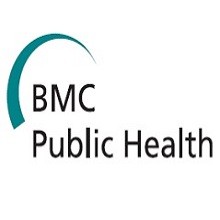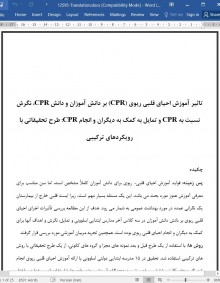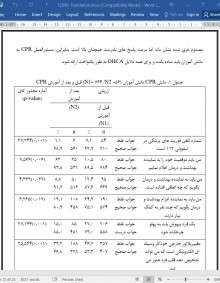
دانلود مقاله تاثیر آموزش احیای قلبی ریوی (CPR) بر دانش آموزان و دانش CPR، نگرش نسبت به CPR
چکیده
پس زمینه: فواید آموزش احیای قلبی- ریوی برای دانش آموزان کاملاً مشخص است، اما سن مناسب برای معرفی آموزش هنوز مورد بحث می باشد. این یک مسئله بسیار مهم است، زیرا ایست قلبی خارج از بیمارستان یک نگرانی عمده در مورد بهداشت عمومی به شمار می رود. هدف از این مطالعه بررسی تأثیرات اجرای احیای قلبی ریوی بر دانش دانش آموزان در سه کلاس آخر مدارس ابتدایی اسلوونی و تمایل، نگرش و اهداف آنها برای کمک به دیگران و انجام احیای قلبی ریوی بوده است. همچنین تجربه مربیان آموزشی مورد بررسی قرار گرفت.
روش ها: با استفاده از یک طرح قبل و بعد نمونه های مجزا و گروه های کانونی، از یک طرح تحقیقاتی با روش های ترکیبی استفاده شد. تحقیق در 15 مدرسه ابتدایی دولتی اسلوونی با ارائه آموزش احیای قلبی ریوی انجام شد. گروه های کانونی شامل مربیان و توسعه دهندگان آموزش بودند. داده ها با استفاده از پرسشنامه ساختار یافته از آوریل تا ژوئن 2018 جمع آوری و با استفاده از تحلیل های تک متغیره و دو متغیره تجزیه و تحلیل شدند. سه گروه کانونی در سپتامبر و اکتبر 2018 تشکیل شد. تجزیه و تحلیل محتوای رونویسی بحث انجام شد. این نمونه شامل 764 دانش آموز در سنین 12.5–14.5 سال قبل از آموزش احیای قلبی ریوی و 566 دانش آموز پس از آموزش بود. سه گروه کانونی غیر همگن شامل هشت مربی احیای قلبی ریوی بودند.
نتایج: پس از اجرای آموزش، پیشرفت چشمگیری در دانش احیای قلبی ریوی مشاهده شد که بیشترین پیشرفت در جوانترین گروه سنی (میانگین سنی 12.5 سال) مشاهده شد. بیشترین افزایش بعد از آموزش برای متغیرهای نگرش نسبت به کمک به دیگران (0.001 = p) و اعتماد به نفس (0.001 = p) مشاهده شد. تجزیه و تحلیل گروه های کانونی دو موضوع را به همراه داشت: (الف) تأثیرات آموزش احیای قلبی ریوی بر دانش آموزان و (ب) مسئولیت سیستمی سیستم مدرسه و نهادهای حرفه ای.
نتیجه گیری: پیشرفت چشمگیری در دانش احیای قلبی - ریوی دانش آموزان پس از آموزش ایجاد شد. آشناسازی زودهنگام آموزش توصیه می شود. دانش احیای قلبی ریوی، آگاهی از مسئولیت کمک به دیگران و اعتماد به نفس را برای تأمین احیای قلبی ریوی در کنار هم افزایش می دهد. می توان نتیجه گرفت که آموزش احیای قلبی ریوی زودهنگام برای کودکان بسیار مهم است. این موضوع در کشورهایی که احیای قلبی ریوی هنوز اجباری نیست، باید به عنوان بخش اجباری از برنامه های درسی مدارس گنجانده شود.
پس زمینه
ایست قلبی خارج از بیمارستان (OHCA) یک نگرانی عمده در زمینه بهداشت عمومی است که تعداد قابل توجهی از مرگ و میر در سراسر جهان را به خود اختصاص داده است. هر ساله بیش از 700000 نفر در اروپا و ایالات متحده از OHCA رنج می برند. میزان زنده ماندن تا ترخیص از بیمارستان پس از OHCA کم بوده و از 5 تا %10 متغیر است. احیا قلبی- ریوی در تصادف برای بهبود شانس زنده ماندن بیمارانی که ناگهانی ایست قلبی می کنند و نتایج عصبی آنها بسیار مهم است. نرخ CPR در شرایط تصادف در کشورهای اروپایی بسیار متفاوت است. تخمین زده می شود که حداقل %15 از افراد برای افزایش قابل توجه میزان زنده ماندن بعد از OHCA باید تحت CPR آموزش ببینند، اما این امر فقط با آموزش های داوطلبانه فقط برای افراد غیر متخصص حاصل نمی شود. بنابراین، آموزش اجباری دانش آموزان یک اقدام مهم است.
آگاهی از اهمیت CPR باید در آموزش اولیه کودکی افزایش یابد ، زیرا آموزش CPR فرهنگ ایمنی در مدارس را بهبود می بخشد و مسئولیت را از بزرگسالان به کودکان منتقل می کند، که می تواند منجر به تغییرات ساختاری طولانی مدت شود.
معرفی آموزش CPR در مدارس توسط سازمان بهداشت جهانی حمایت شده است. در اسکاندیناوی، آموزش CPR به دانش آموزان مدارس باعث افزایش CPR توسط همراهان و در نتیجه میزان زنده ماندن بالاتر از OHCA شده است. علاوه بر این، بهره وری جامعه افزایش می یابد و در نتیجه، هزینه های مراقبت های بهداشتی کاهش پیدا می کند. در بعضی از کشورها، آموزش CPR برای دانش آموزان در حال حاضر اجباری است، در برخی دیگر این آموزش به تدریج، با 2 ساعت آموزش CPR در سال، در برنامه های درسی قرار می گیرد. با این وجود، سن مناسب برای شروع آموزش CPR همچنان بحث برانگیز است. اگر کودکان در سنین پایین CPR را یاد بگیرند، آموزش مهارت های زندگی (نجات غریق)، مانند مهارت های شنا یا دوچرخه سواری را فراموش نمی کنند. بعلاوه، کودکان می توانند به عنوان تقویت کننده CPR عمل کنند زیرا آنها می توانند آگاهی و مهارتهای CPR را به اعضای خانواده و دوستانشان منتقل نمایند. مزایای آموزش اولیه CPR با نگرش نسبت به کمک به دیگران، افزایش اعتماد به نفس در نتیجه مثبت احیا، انگیزه درونی برای کمک به افرادی که نیاز به کمک دارند و ایجاد همدلی منعکس می شود.
نتیجه گیری
یافته های تحقیق زمینه را برای تصمیم گیرندگان فراهم می کند تا آموزش CPR را به عنوان بخشی اجباری از برنامه های درسی مدارس معرفی کنند. ما همچنین باید آگاه باشیم که تلاش برای تبدیل مباحث CPR به بخشی اجباری از برنامه های مدارس تنها با استفاده از یک رویکرد جامع، مسئولانه و با آگاهی از مسئولیت اجتماعی می تواند موفقیت آمیز باشد. با این وجود، درگیر کردن آموزش CPR در برنامه های درسی بسیار مهم است. جوانترین گروه سنی (5/12 سال) بیشترین پیشرفت را در دانش CPR داشته اند.
نتایج تحقیقات کمی و کیفی به وضوح تأثیرات مثبت آموزش دانش آموزان در CPR را نشان می دهد. ما دریافتیم که سطح دانش CPR با تمایل، نگرش و نیت برای کمک به عوامل مهم دیگر در رشد اجتماعی دانش آموزان و رشد ارزش ها، عقاید و اعتقادات آنها ارتباط دارد. این تحقیق سهم مهمی در سیاست های بهداشت عمومی دارد. این معیارهایی را برای اجرای آموزش دانش آموزان در CPR فراهم می کند ، که یکی از عوامل مهم در افزایش میزان زنده ماندن در شرایط ایست قلبی است.
یافته های مطالعه ما برای تصمیم گیرندگان و توسعه دهندگان برنامه های درسی مدارس که مسئولیت آموزش CPR را به عنوان بخشی اجباری از برنامه درسی مدرسه بر عهده دارند، حائز اهمیت است. آموزش CPR باید به طور مداوم و برای چندین سال از زمان 12 سالگی دانش آموزان انجام شود و باید بخشی از برنامه های درسی اجباری مدارس باشد. با این کار، ما معتقدیم که نتایج CPR در قربانیان ایست قلبی می تواند در آینده به طور قابل توجهی بهبود یابد. علاوه بر این، تجهیزات لازم، مواد آموزشی و وسایل کمک آموزشی باید در دسترس مربیان آموزش CPR، هم برای آموزش نظری و هم برای آموزش عملی باشد، زیرا برای یادگیری کارآمد ضروری هستند. این تجهیزات را باید موسسات مسئول ارائه آموزش CPR با استفاده از AED تهیه کنند.
Abstract
Background The benefits of cardiopulmonary resuscitation training for schoolchildren are well known, but the appropriate age for introducing training is still being discussed. This is a very important issue, since out-of-hospital cardiac arrest is a major public health concern. The objective of this study was to investigate the effects of implemented cardiopulmonary resuscitation training on the knowledge of schoolchildren in the last three grades of Slovenian elementary schools and theirs willingness, attitudes, and intentions toward helping others and performing cardiopulmonary resuscitation. The experience of training instructors was also explored.
Methods A mixed methods research design was employed, using a Separate Pre-Post Samples Design and focus groups. Research was conducted in 15 Slovenian public elementary schools offering cardiopulmonary resuscitation training. Focus groups included training instructors and developers. Data was collected with a structured questionnaire from April to June 2018 and analyzed using univariate and bivariate analyses. The three focus groups were convened in September and October 2018. Content analysis of the discussion transcriptions was conducted. The sample included 764 schoolchildren aged 12.5–14.5 years before cardiopulmonary resuscitation training and 566 schoolchildren after training. Three non-homogeneous focus groups included eight cardiopulmonary resuscitation instructors.
Results Significant progress in cardiopulmonary resuscitation knowledge was noted after training implementation, with the greatest progress seen in the youngest age group (mean age 12.5). The greatest increase after training was seen for the variables Attitude toward helping others (p = 0.001) and Self-confidence (p = 0.001). Analysis of the focus groups yielded two themes: (a) the effects of cardiopulmonary resuscitation training on schoolchildren, and (b) the systemic responsibility of the school system and professional bodies.
Conclusions Significant progress in schoolchildren’s cardiopulmonary resuscitation knowledge after training was established. Early introduction of training is recommended. Cardiopulmonary resuscitation knowledge raises awareness of the responsibility to help others and increases self-confidence to provide bystander cardiopulmonary resuscitation. It can be concluded that early cardiopulmonary resuscitation training for children is crucial. It should be a mandatory part of school curricula in those countries where cardiopulmonary resuscitation is not yet mandatory.
Background
Out-of-hospital cardiac arrest (OHCA) is a major public health concern accounting for a substantial number of deaths worldwide. Each year, over 700,000 people in Europe and the USA suffer from OHCA. The survival to hospital discharge rate following OHCA remains low, ranging from 5 to 10% [1–3]. Bystander cardiopulmonary resuscitation (CPR) is crucial for improving the chances of survival of sudden cardiac arrest patients and their neurological outcomes [4]. Bystander CPR rates differ widely across European countries [3]. It is estimated that at least 15% of the population would have to be trained in CPR for a significant increase in survival rates after OHCA, but this cannot be achieved through voluntary trainings for the lay population alone; therefore, mandatory training of schoolchildren would be an important measure [5, 6].
Awareness of the importance of CPR must be raised in early childhood education [7], as CPR training improves the safety culture in schools and shifts the responsibility from adults to children, which could result in long-term structural changes [6].
The introduction of CPR training in schools has been advocated by the World Health Organization [5]. In Scandinavia, teaching schoolchildren CPR has increased lay bystander CPR rates, resulting in higher survival rates after OHCA. Besides that, the productivity of society raises and consequently, the costs of health care decline [8]. Teaching the importance of OHCA recognition and CPR skills should begin early, as schoolchildren have greater motivation and learn faster than adults and also maintain learning abilities [9, 10]. In some countries, CPR training for schoolchildren is already mandatory, in others it is being gradually introduced into curricula, with 2 hours of CPR training a year being recommended [11]. Nevertheless, the appropriate age to start CPR training remains controversial. If children learn CPR at a young age, they will not forget lifesaving skills, much like swimming or bike-riding skills [7]. In addition, children can serve as CPR multipliers as they may pass on the acquired awareness and CPR skills to family members and friends [12]. The advantages of early CPR teaching are reflected by attitude toward helping others, increased confidence in the positive outcome of resuscitation, internal motivation to help people requiring assistance, and development of empathy [13–17].
Conclusions
The research findings provide the basis for decisionmakers to introduce CPR training as mandatory part of school curricula. We must also be aware that the endeavors for CPR topics to become a mandatory part of school programs can only be successful by employing a comprehensive, responsible approach and with the awareness of social responsibility. Nevertheless, it is very important to involve the CPR training into curricula. The youngest age group (12.5 years) made the most progress in CPR knowledge.
Results of the quantitative and qualitative research clearly demonstrate the positive effects of training schoolchildren in CPR. We found that the level of CPR knowledge correlated with the willingness, attitudes and intentions toward helping others important factors in schoolchildren’s social development and the development of their values, opinions, and beliefs. This research gives an important contribution to public health policy. It provides criteria for implementation of training schoolchildren in CPR, which is one of crucial factors of higher survival rate at cardiac arrest.
Our study findings are important for decision-makers and developers of school curricula who are responsible for making CPR training a mandatory part of school curricula. CPR training should be conducted continuously, for several years from the time schoolchildren are 12, and should be part of the mandatory school curricula. By doing so, we believe that CPR outcomes in cardiac arrest victims could significantly improve in the future. What is more, the necessary equipment, teaching materials, and teaching aids should be available to CPR training instructors, both for theoretical and practical training, as they are indispensable for efficient learning. This equipment should be provided by the institutions responsible for offering CPR training with the use of AED.
چکیده
پس زمینه
هدف مطالعه
مواد و روش ها
طرح
تنظیم سازی و شرکت کنندگان
طراحی قبل و بعد نمونه های جداگانه
گروه کانونی (متمرکز)
ابزار
طرح قبل و بعد نمونه های مجزا
مطالعه آزمایشی
ابزار گروه تمرکز
جمع آوری داده
تحلیل داده ها
نتایج
دانش CPR و تمایل، نگرش و نیت برای کمک به دیگران قبل و بعد از آموزش CPR
دیدگاه مربیان و تجربه های آموزش CPR
بحث
محدودیت ها و نقاط قوت
نتیجه گیری
منابع
Abstract
Background
Aim of the study
Methods
Design
Setting and participants
Separate pre-post samples design
Focus group
Instrument
Separate pre-post samples design
Pilot study
Focus group instrument
Data collection
Data analysis
Results
CPR knowledge and the willingness, attitudes and intentions toward helping
others prior to and after CPR training
Instructors’ perspectives on and experiences with CPR training
Discussion
Conclusions
References
- اصل مقاله انگلیسی با فرمت ورد (word) با قابلیت ویرایش
- ترجمه فارسی مقاله با فرمت ورد (word) با قابلیت ویرایش، بدون آرم سایت ای ترجمه
- ترجمه فارسی مقاله با فرمت pdf، بدون آرم سایت ای ترجمه



